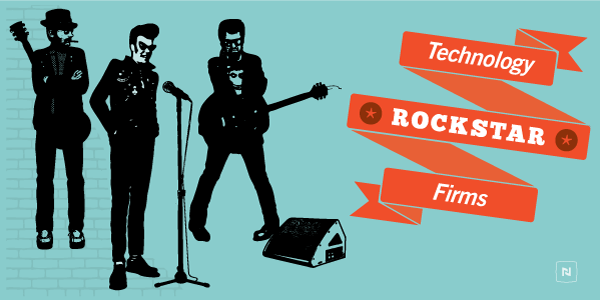It’s a new age for lawyers. Simply providing great legal counsel isn’t enough any more (some would argue it never really was).
Legal technology, including e-discovery technology and evidence management software, can provide a competitive advantage in a highly competitive marketplace.
We’ve compiled seven traits of lawyers and law firms that successfully use legal technology to gain a competitive advantage – both in winning business and in winning litigation. Here’s what makes a “technology rockstar” law firm.
1. They believe in it.
Pretty simple. You’ve got to have a faith in technology as an instrument of change, and as a necessity to modern law practice. No luddites.
Truth is, great legal technology levels the playing field when you are representing under-funded parties in litigation. Smaller firms and businesses know using powerful technology tools allows them to compete successfully against their larger, well-funded opponents.
On the other side, larger firms should realize that more technology-agile opponents will exploit any disparity. They recognize and believe in the power of technology. Great lawyers in big firms don’t allow it to become an advantage for their opponent no matter their stature.
2. They know how to sell it to their clients.
Technology-forward firms sell an unwavering belief in technology as a game-changer to their clients. They evangelize the direct impact tech has on efficiency, collaboration, speed and agility in the mechanics of their case.
Rockstar firms show their clients that technology gives them a better chance of winning – or at a minimum, is a necessity for keeping pace with their opposition. These firms leverage technology to be more efficient, which effectively lowers the clients’ legal bills. Which leads us directly to #3:
3. They don’t pay for it.
Firms of all sizes who have successfully cracked the technology equation don’t invest their own money in it. It’s simple business logic. Charge for your actual value-add, and pass through all ancillary costs to the client.
After all, firms don’t build or buy jet planes to shuttle their lawyers to client meetings. They use airlines, and pass through the travel expenses.
Successfully leveraging technology in litigation means effectively defining a process to pass the cost through to the end client.
Clients appreciate this. They recognize that firms who are not passing through their costs have no incentive to invest in state-of-the-art technology. This helps no one. (See our earlier post: Eliminate Litigation Technology Costs and Reduce Risk )
4. They use it at every step in the process.
When you’re a technology rockstar law firm, using great technology is not a point solution, appropriate only for certain matters. It’s a soup-to-nuts approach to building a successful practice and getting more business done in a more efficient manner.
The average American looks at their cellphone over a 100 times a day. The glory of personal and business technologies that have shrunk our world and accelerated the movement of information have also caused a rise in complexity in the law. More data. More filetypes. More discovery.
Fight fire with fire – Internet technology is the problem and Internet technology is the obvious solution.
Great lawyers bake technology into every step of their practice from business development, to practice management, through prep and presentation at trial. If technology can make your team more efficient in all the areas that are interfering with your ability to ” just practice law,” why not use it as much as possible?
If your firm is still treating technology like a highly specialized service, using it rarely and paying other professionals to run it for you (think x-ray machine for doctors), you are no rockstar.
5. They are fearless.
Litigation is adversarial. The side who flinches first, often loses. Firms confident in their technology backbone are much less likely to flinch at massive productions, protracted timelines, or extended settlement negotiations.
Technology rockstar firms have a range of approaches, appropriate to the scope of every matter. The confidence of knowing they can handle the full spectrum of potential gambits lets them take the harder line in settlement negotiations, gives them more credibility with a judge, and makes them unafraid of going to trial.
Some may mention the issue of “asymmetrical litigation,” a David v. Goliath situation where technology costs are an impediment to aggressively litigating a matter for the Davids of the world. I would suggest that today’s modern litigation technology (and especially those harnessing the power of cloud computing) is the very thing that is neutralizing any disparity between sides in this type of scenario.
6. They leverage technology to win clients.
Most firms would like to win business on the merits of their legal counsel alone, but that just isn’t reality anymore.
Firms winning lots of business these days are those who know how to solve business problems for their clients. They convince clients that not only can they handle the legal issues in the case with aplomb, but they can efficiently manage the whole ball of wax and the enchilada as well.
That includes skillfully deploying technology surrounding data management. Any litigation today involves electronic data, generally large volumes of it. Collection of data, forensic analysis of data, filtering of data, processing of data, review of data, production of data, and on and on.
Power firms use technology to fade the complex, electronic data “noise” into the background – leaving their strategic legal skill in the fore.
7. They drive their support staff to be more efficient.
Change happens in a law firm when a partner makes it happen. With a leader at the top who ensures everyone is operating at peak performance, a firm dramatically improves its bottom line. Just as these leading firms use technology everywhere (see #4), they also realize technology evolves rapidly.
Great leaders understand the favorable impact to their practice, and push their support staff to find more effective solutions to old problems with the latest technologies.
Which of these traits is your firm demonstrating – and which can it improve upon?







